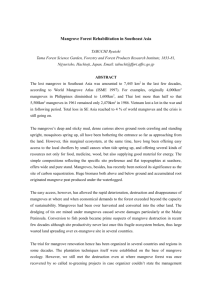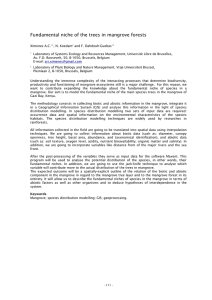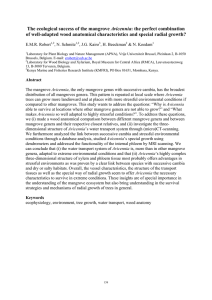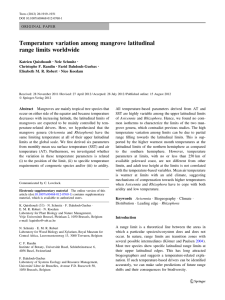CLIMATIC REQUIREMENTS FOR MANGROVES: WHAT DOES
advertisement
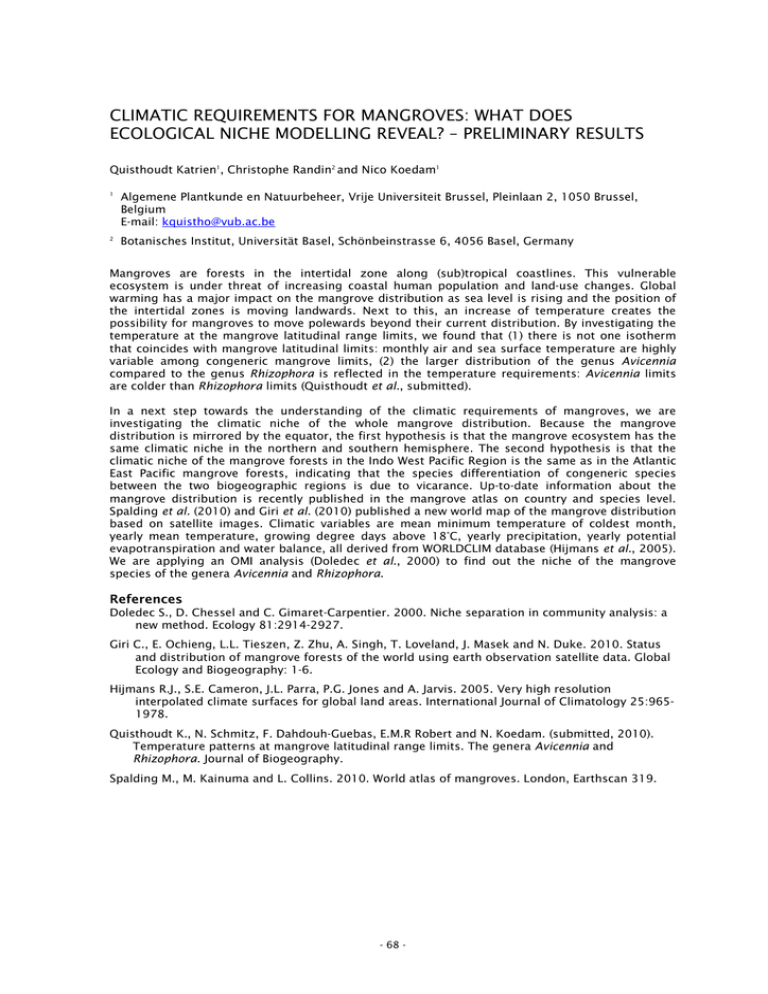
CLIMATIC REQUIREMENTS FOR MANGROVES: WHAT DOES ECOLOGICAL NICHE MODELLING REVEAL? – PRELIMINARY RESULTS Quisthoudt Katrien1, Christophe Randin2 and Nico Koedam1 1 Algemene Plantkunde en Natuurbeheer, Vrije Universiteit Brussel, Pleinlaan 2, 1050 Brussel, Belgium E-mail: kquistho@vub.ac.be 2 Botanisches Institut, Universität Basel, Schönbeinstrasse 6, 4056 Basel, Germany Mangroves are forests in the intertidal zone along (sub)tropical coastlines. This vulnerable ecosystem is under threat of increasing coastal human population and land-use changes. Global warming has a major impact on the mangrove distribution as sea level is rising and the position of the intertidal zones is moving landwards. Next to this, an increase of temperature creates the possibility for mangroves to move polewards beyond their current distribution. By investigating the temperature at the mangrove latitudinal range limits, we found that (1) there is not one isotherm that coincides with mangrove latitudinal limits: monthly air and sea surface temperature are highly variable among congeneric mangrove limits, (2) the larger distribution of the genus Avicennia compared to the genus Rhizophora is reflected in the temperature requirements: Avicennia limits are colder than Rhizophora limits (Quisthoudt et al., submitted). In a next step towards the understanding of the climatic requirements of mangroves, we are investigating the climatic niche of the whole mangrove distribution. Because the mangrove distribution is mirrored by the equator, the first hypothesis is that the mangrove ecosystem has the same climatic niche in the northern and southern hemisphere. The second hypothesis is that the climatic niche of the mangrove forests in the Indo West Pacific Region is the same as in the Atlantic East Pacific mangrove forests, indicating that the species differentiation of congeneric species between the two biogeographic regions is due to vicarance. Up-to-date information about the mangrove distribution is recently published in the mangrove atlas on country and species level. Spalding et al. (2010) and Giri et al. (2010) published a new world map of the mangrove distribution based on satellite images. Climatic variables are mean minimum temperature of coldest month, yearly mean temperature, growing degree days above 18°C, yearly precipitation, yearly potential evapotranspiration and water balance, all derived from WORLDCLIM database (Hijmans et al., 2005). We are applying an OMI analysis (Doledec et al., 2000) to find out the niche of the mangrove species of the genera Avicennia and Rhizophora. References Doledec S., D. Chessel and C. Gimaret-Carpentier. 2000. Niche separation in community analysis: a new method. Ecology 81:2914-2927. Giri C., E. Ochieng, L.L. Tieszen, Z. Zhu, A. Singh, T. Loveland, J. Masek and N. Duke. 2010. Status and distribution of mangrove forests of the world using earth observation satellite data. Global Ecology and Biogeography: 1-6. Hijmans R.J., S.E. Cameron, J.L. Parra, P.G. Jones and A. Jarvis. 2005. Very high resolution interpolated climate surfaces for global land areas. International Journal of Climatology 25:9651978. Quisthoudt K., N. Schmitz, F. Dahdouh-Guebas, E.M.R Robert and N. Koedam. (submitted, 2010). Temperature patterns at mangrove latitudinal range limits. The genera Avicennia and Rhizophora. Journal of Biogeography. Spalding M., M. Kainuma and L. Collins. 2010. World atlas of mangroves. London, Earthscan 319. - 68 -




